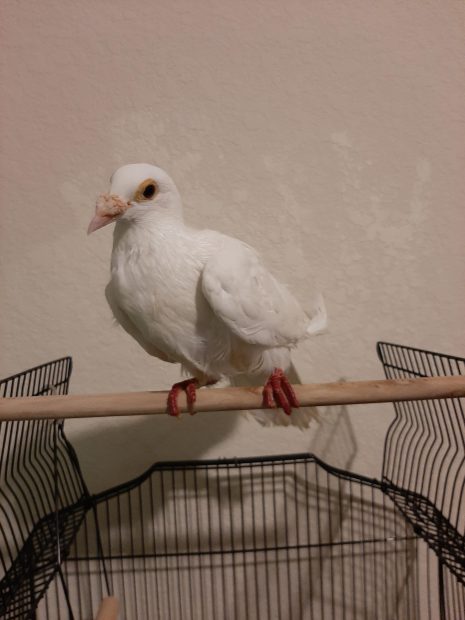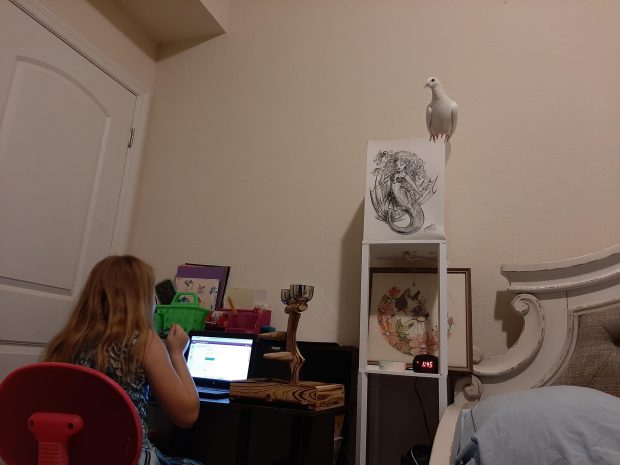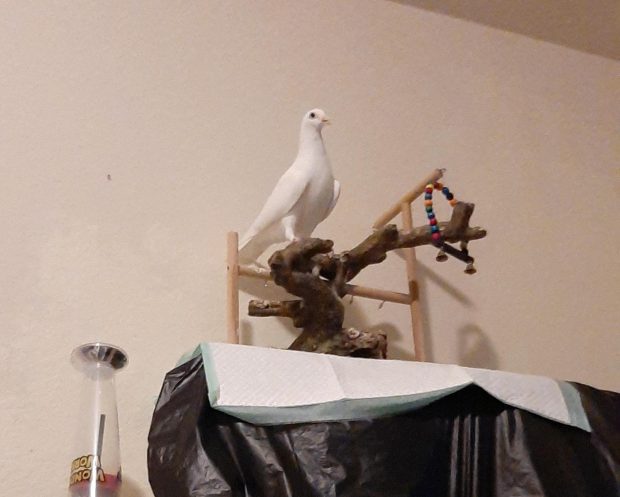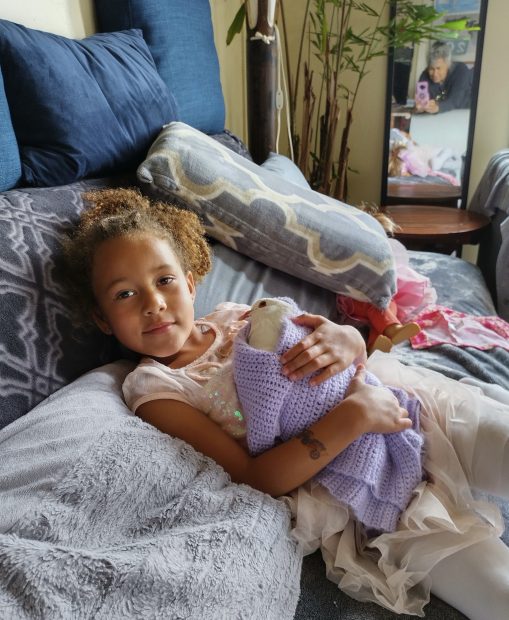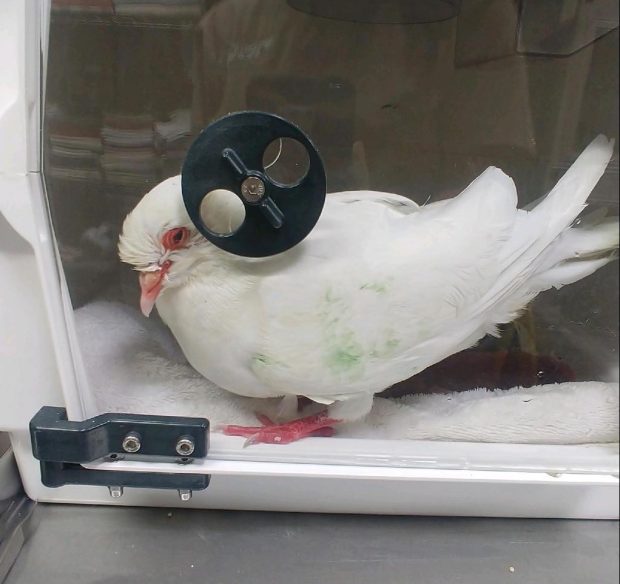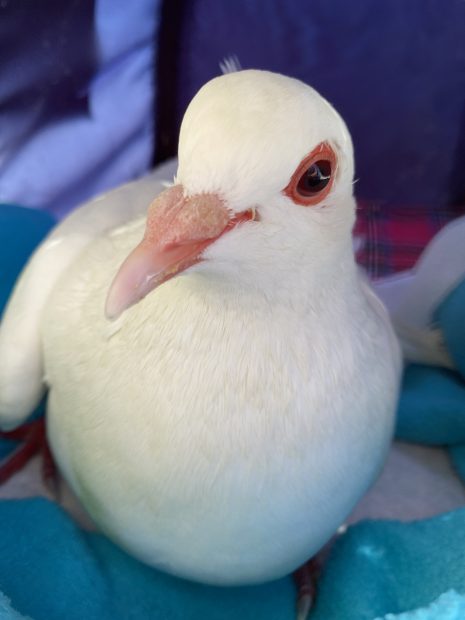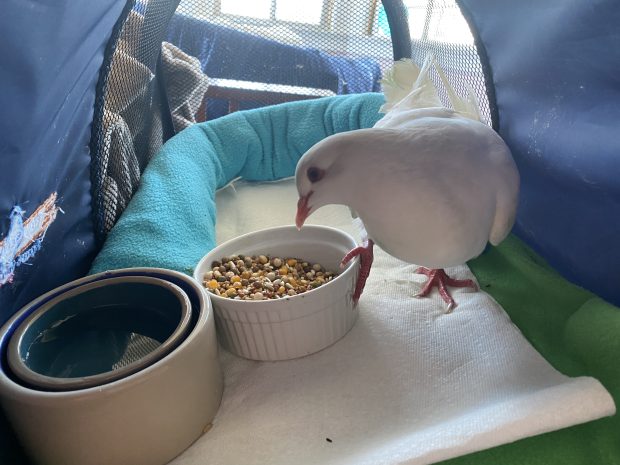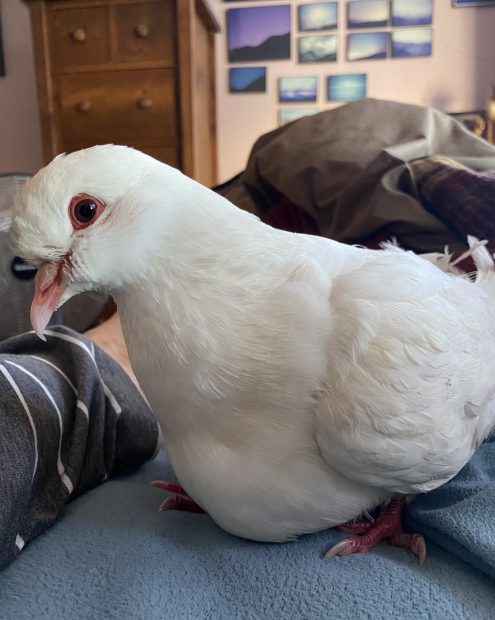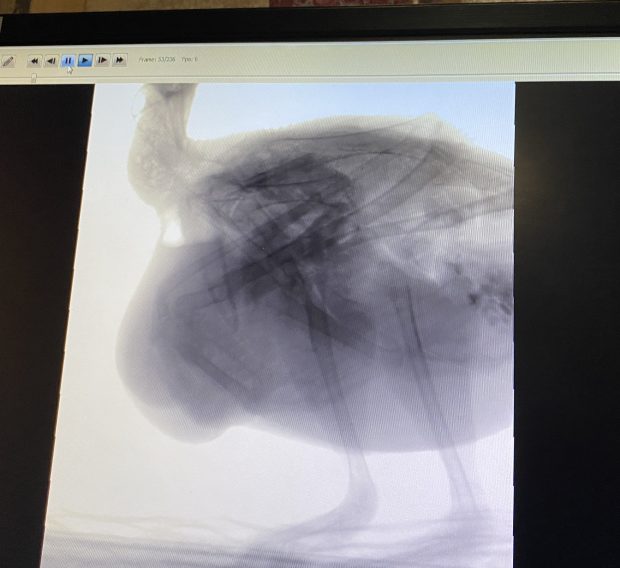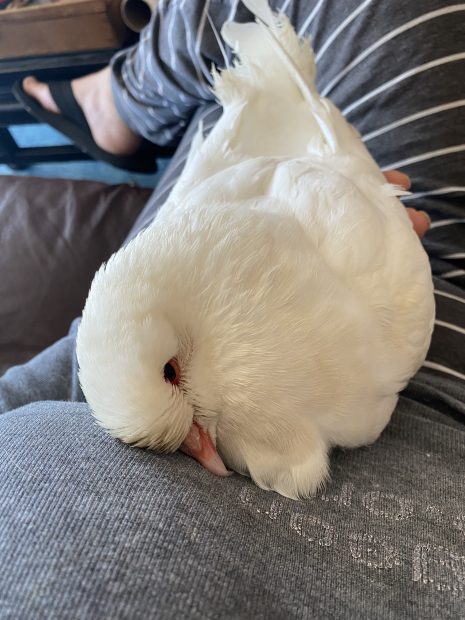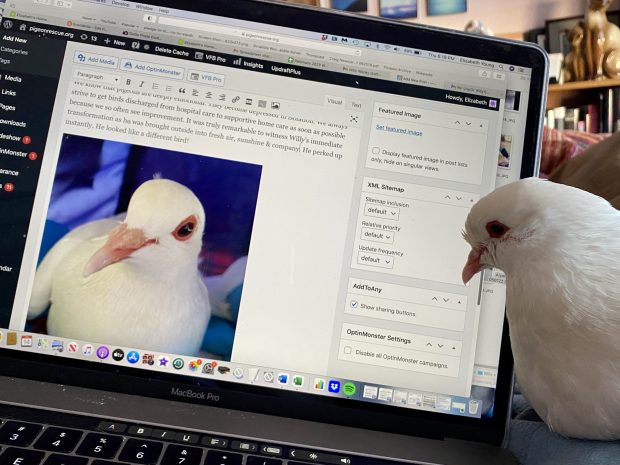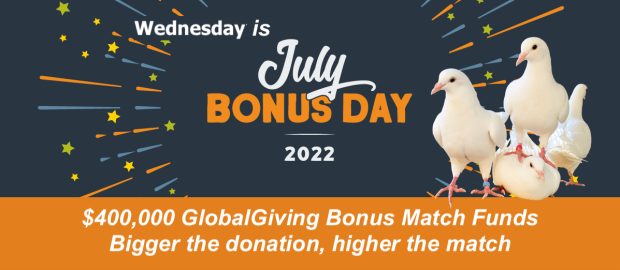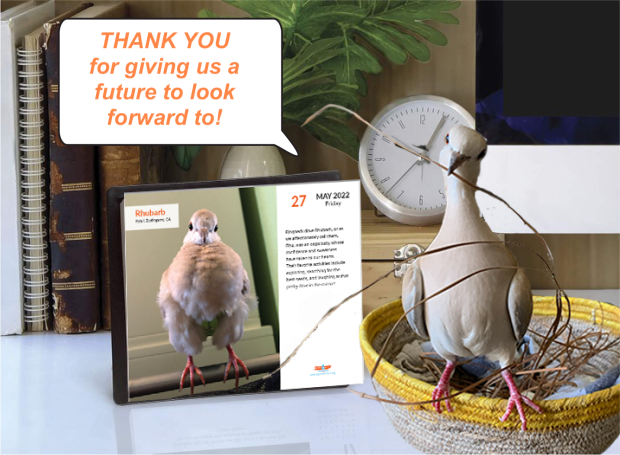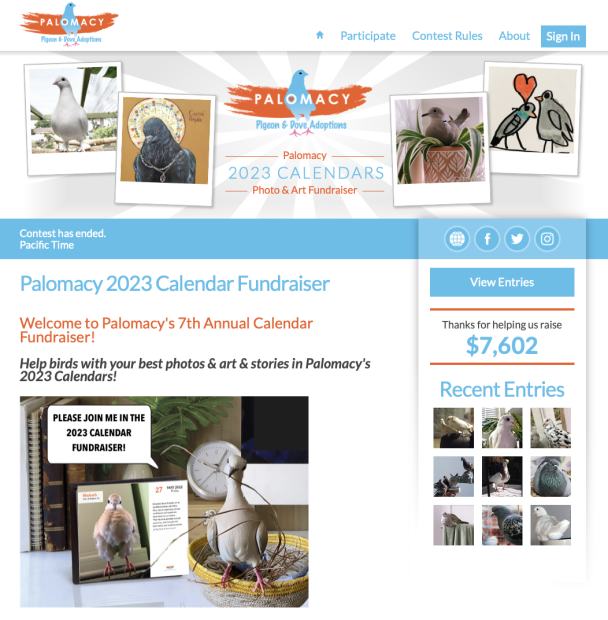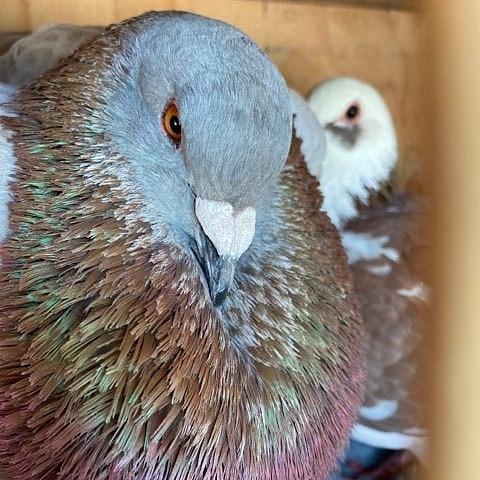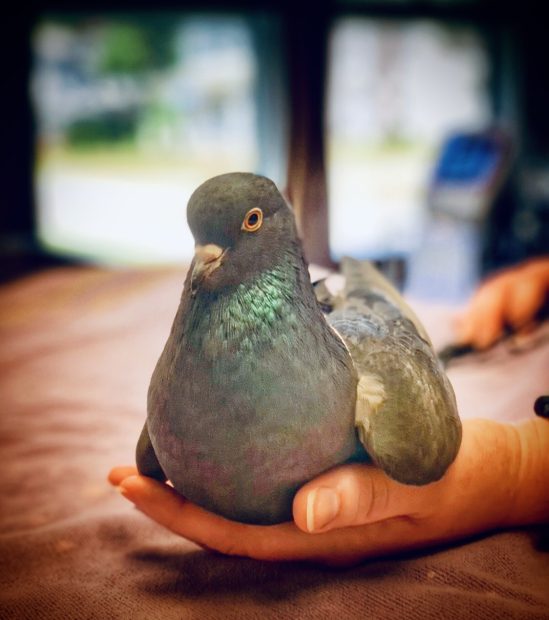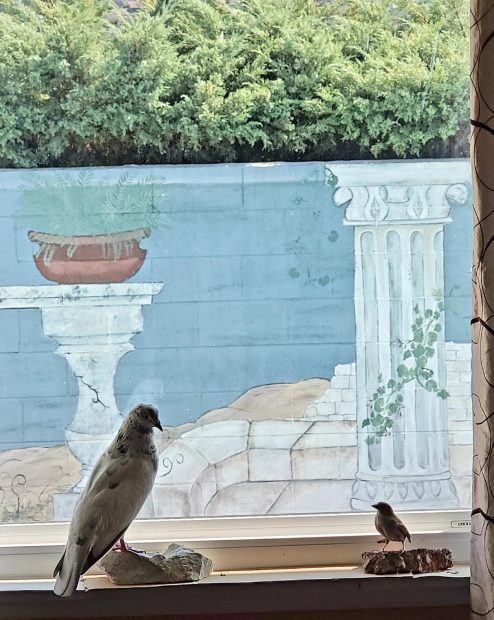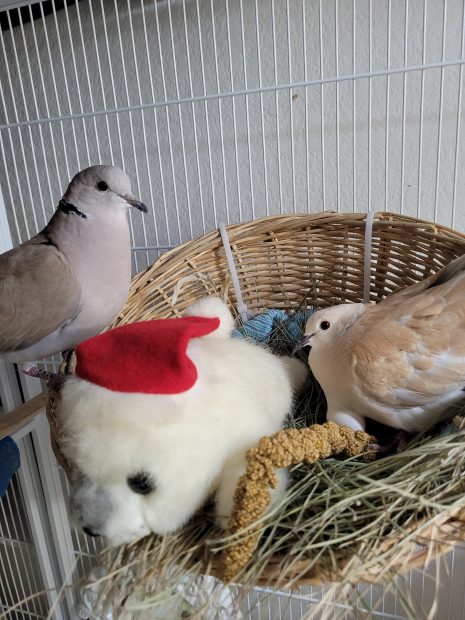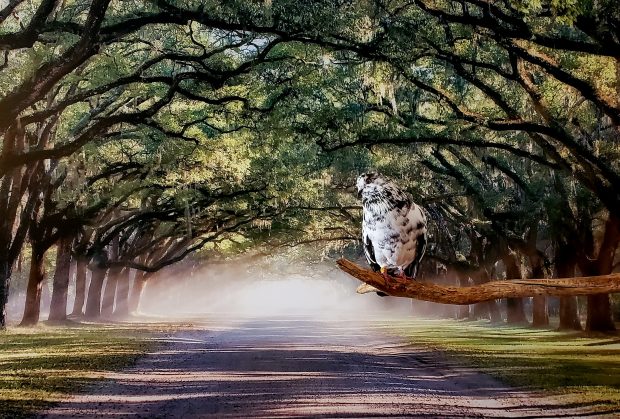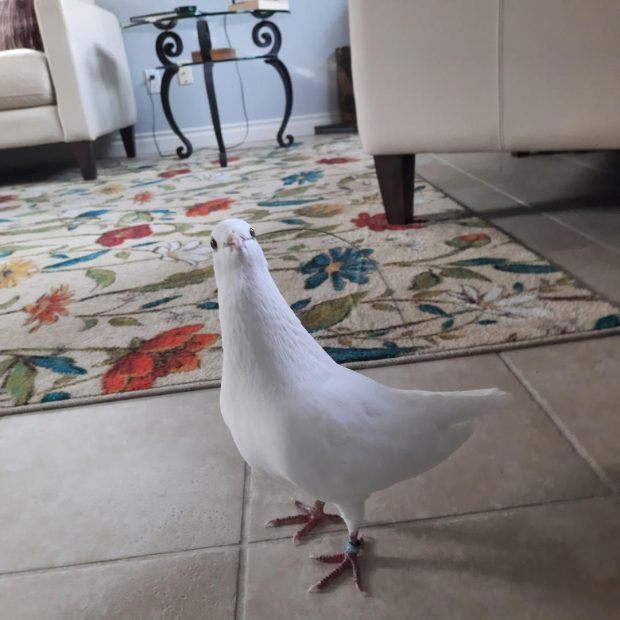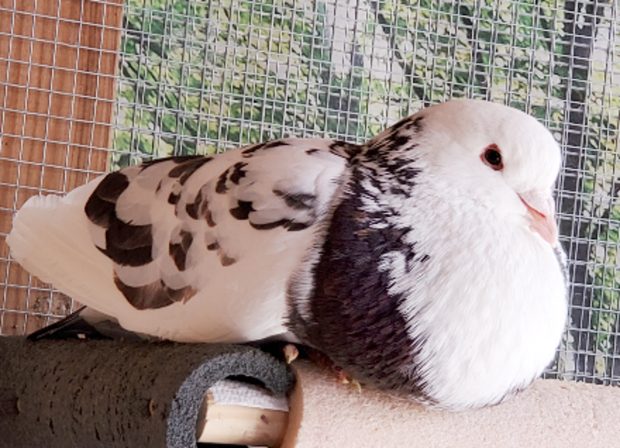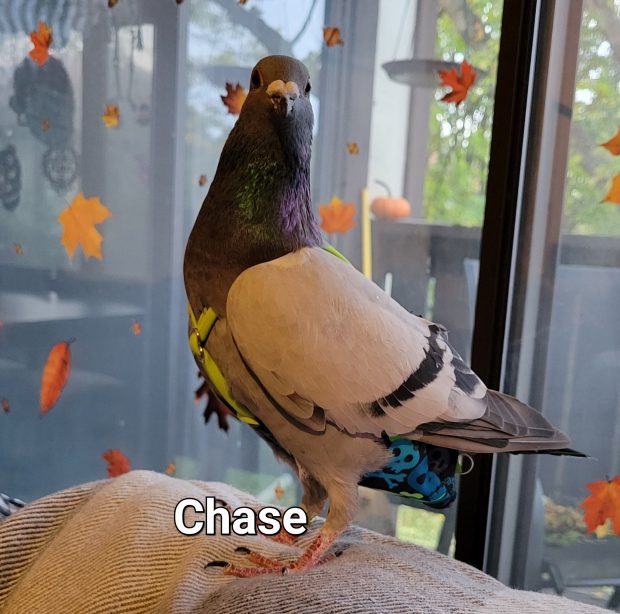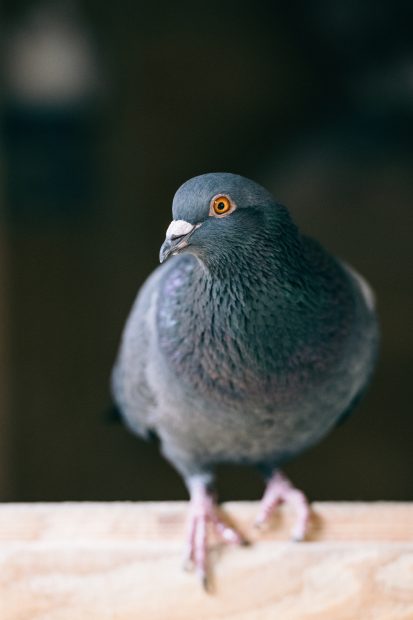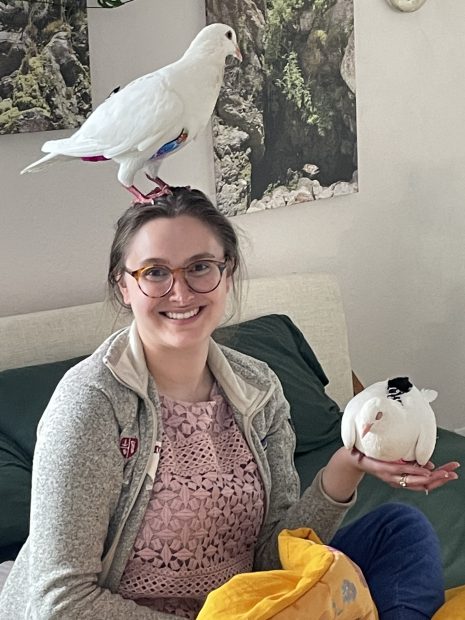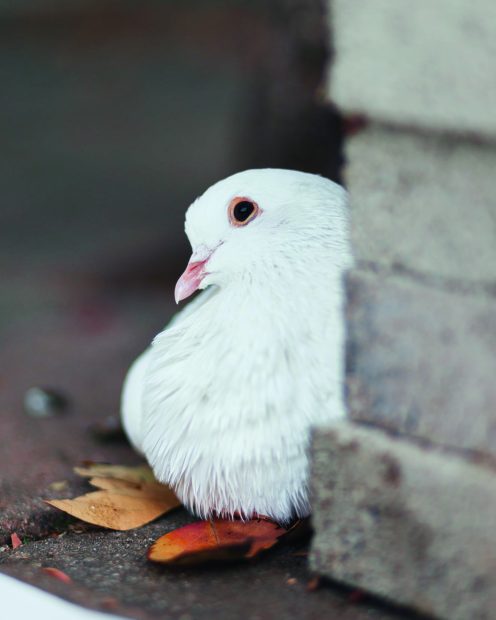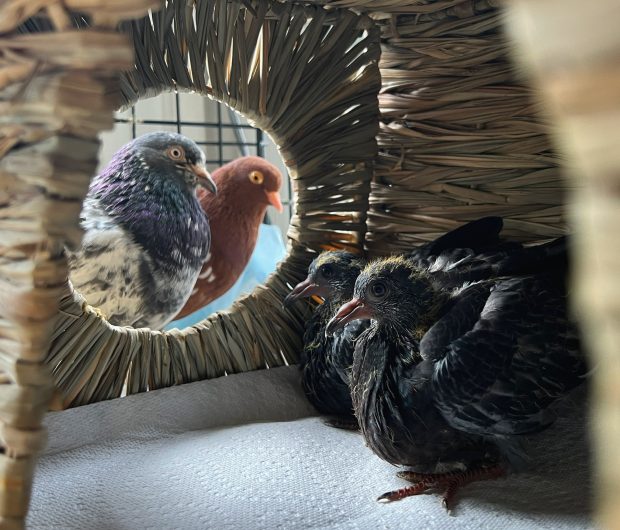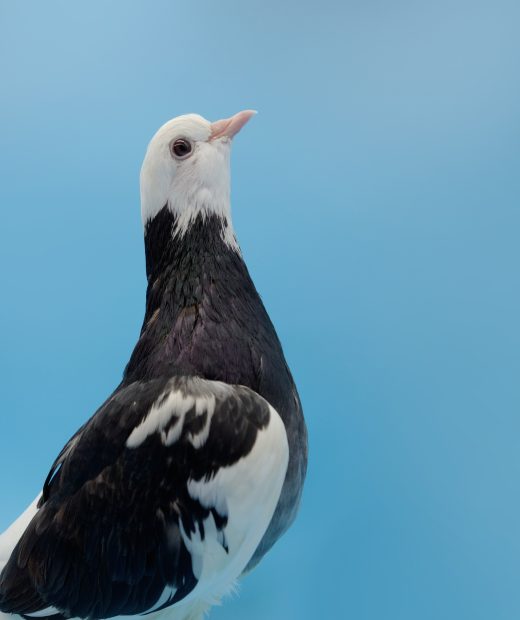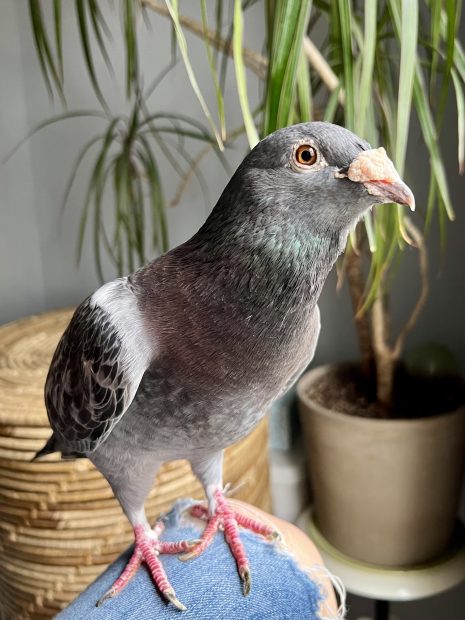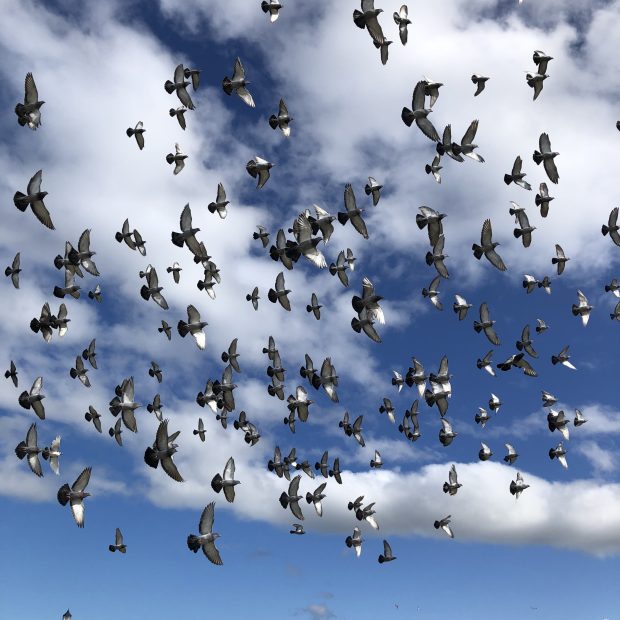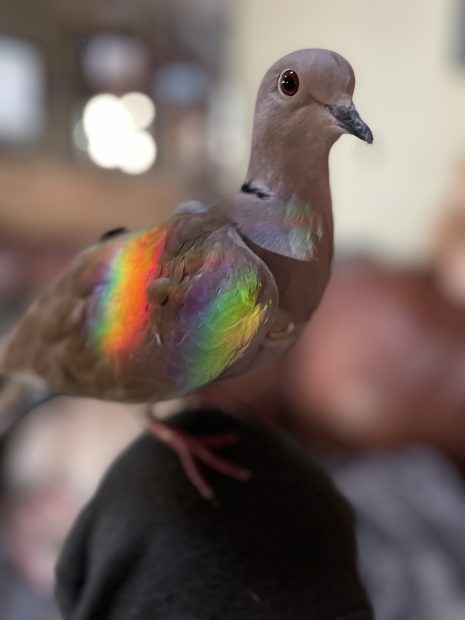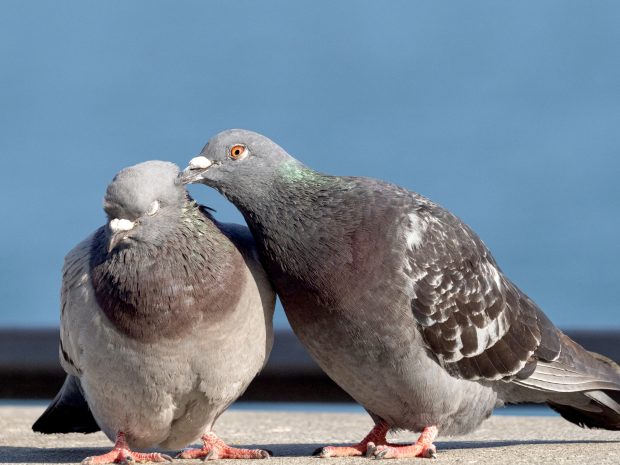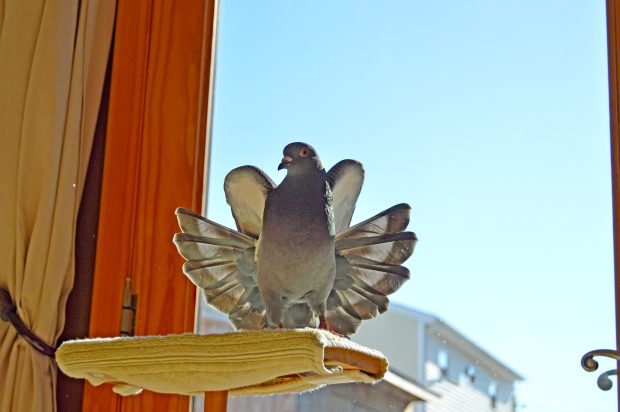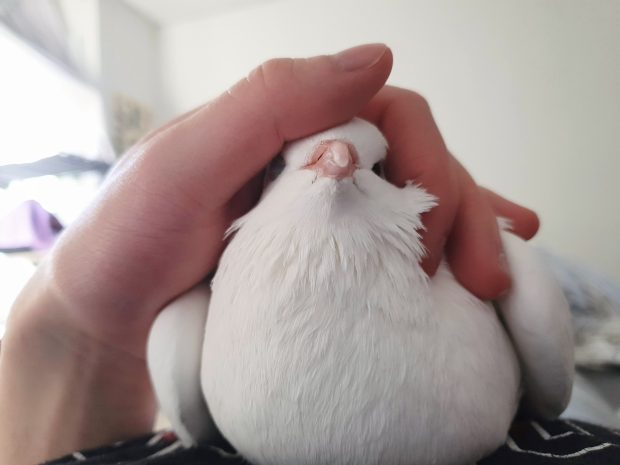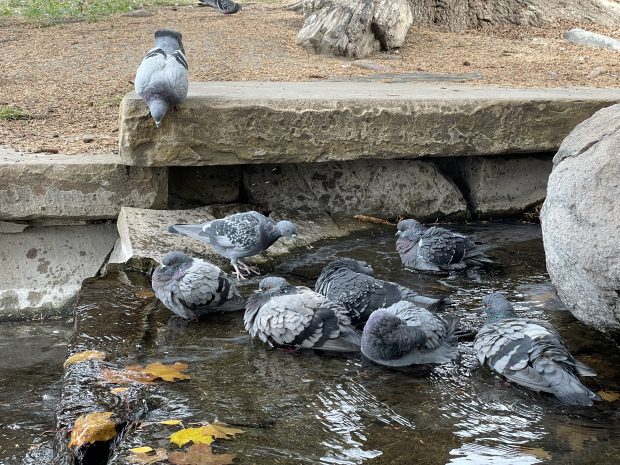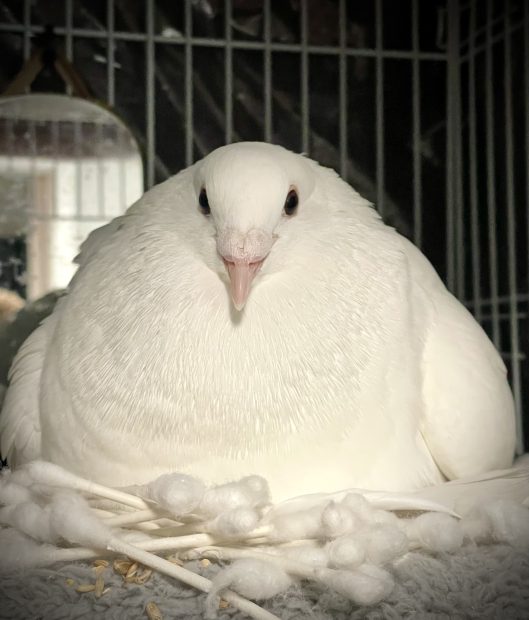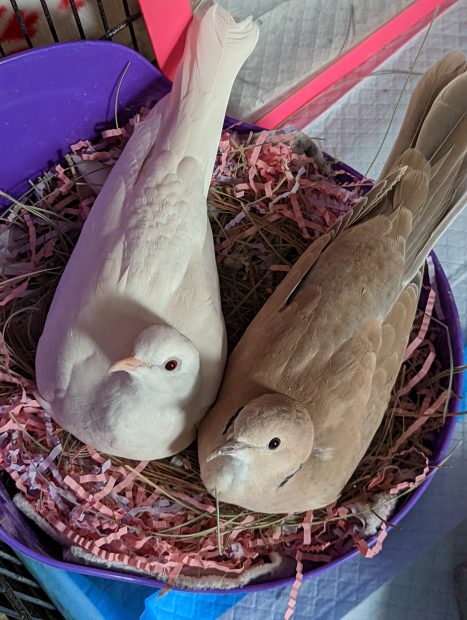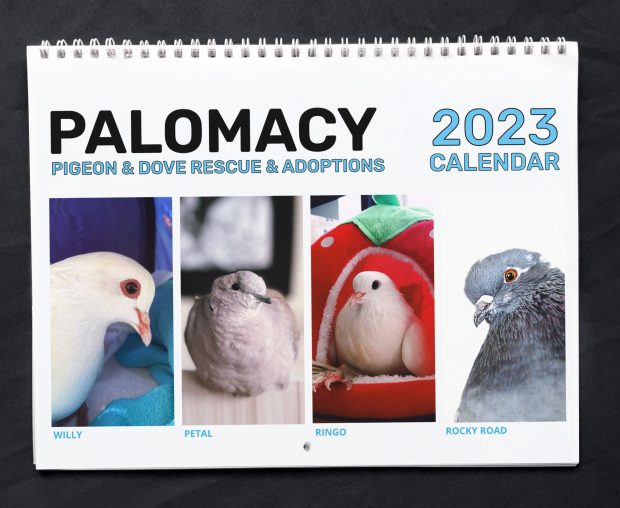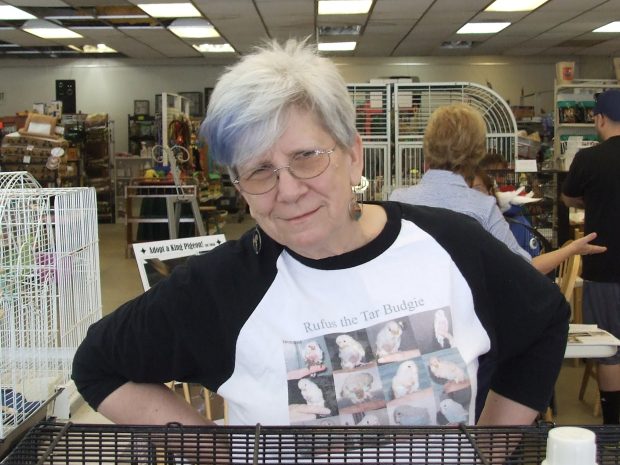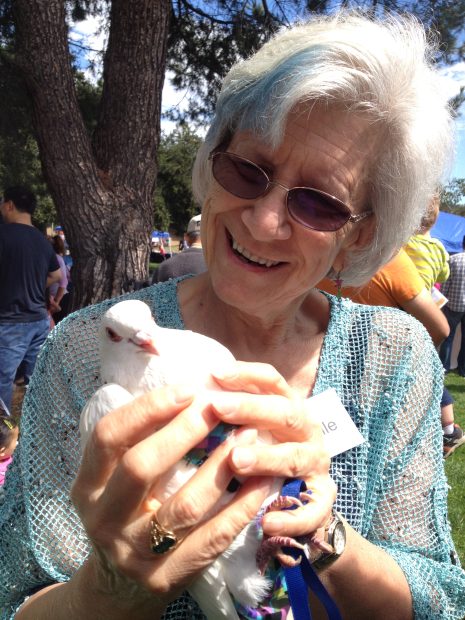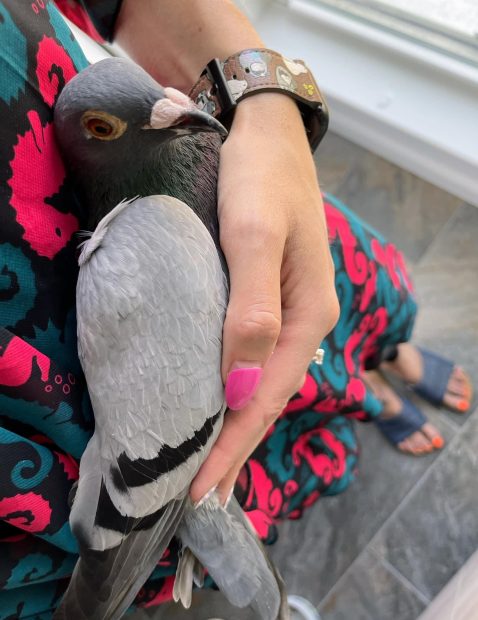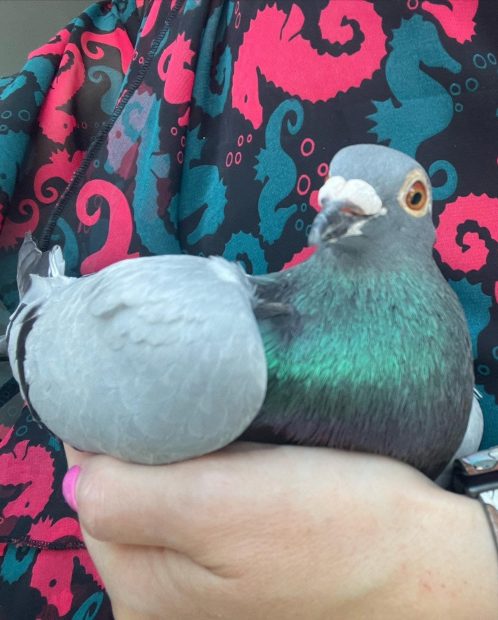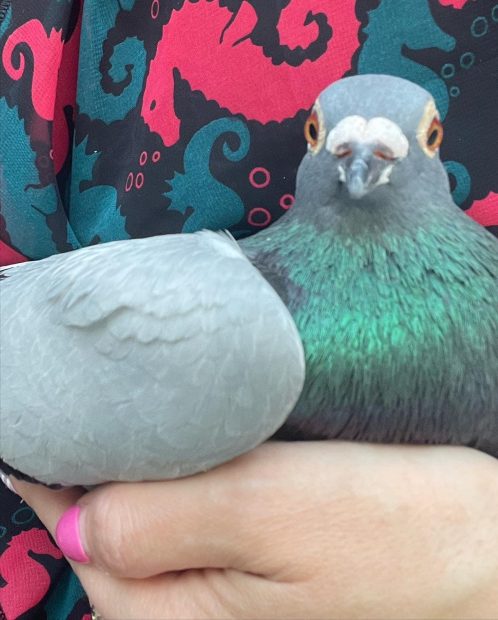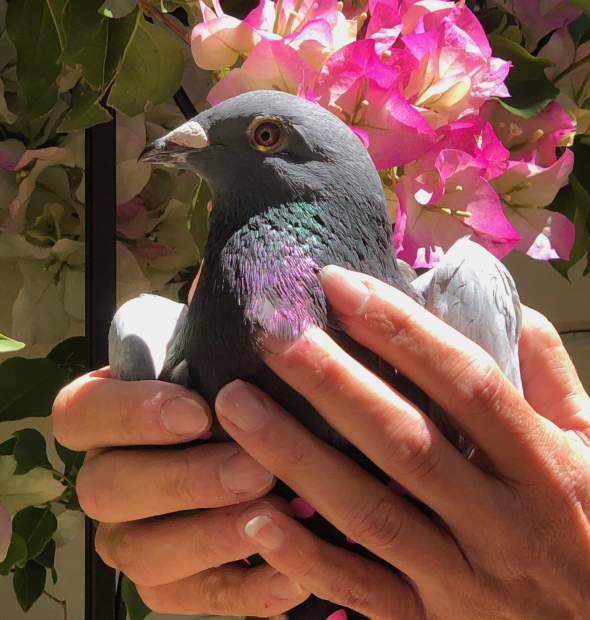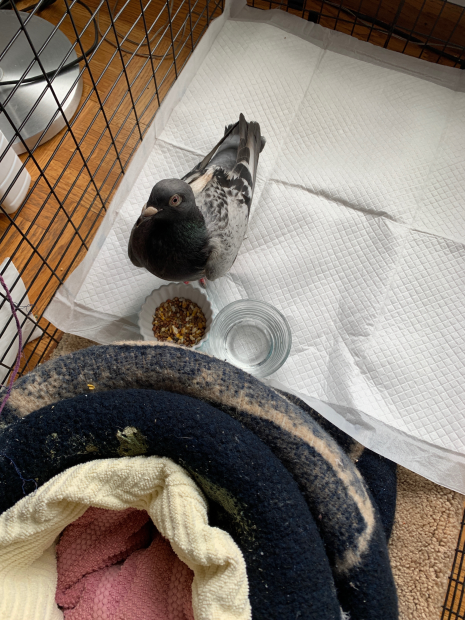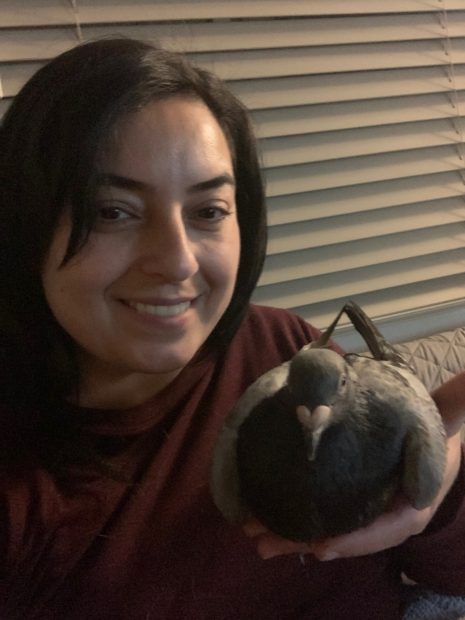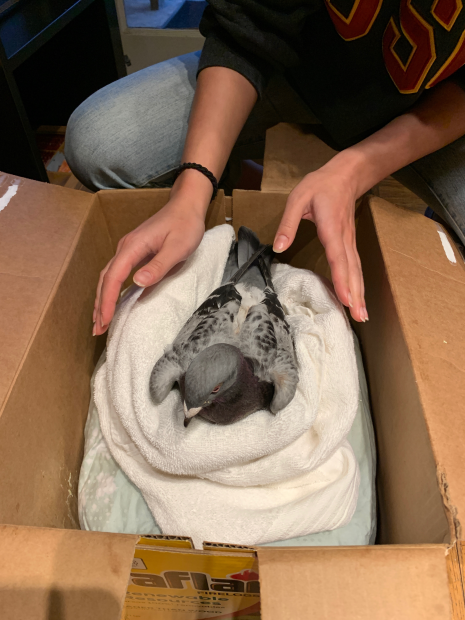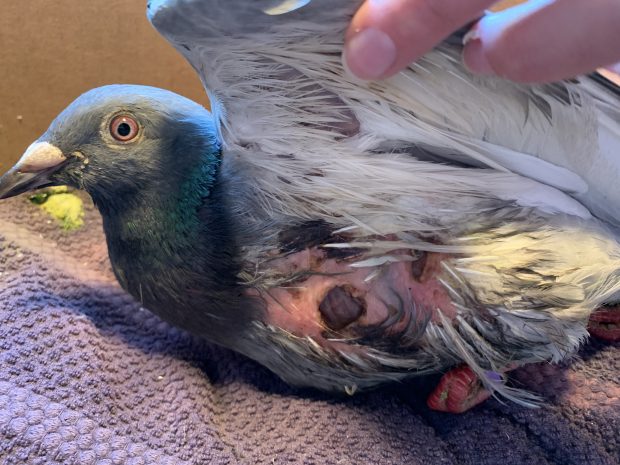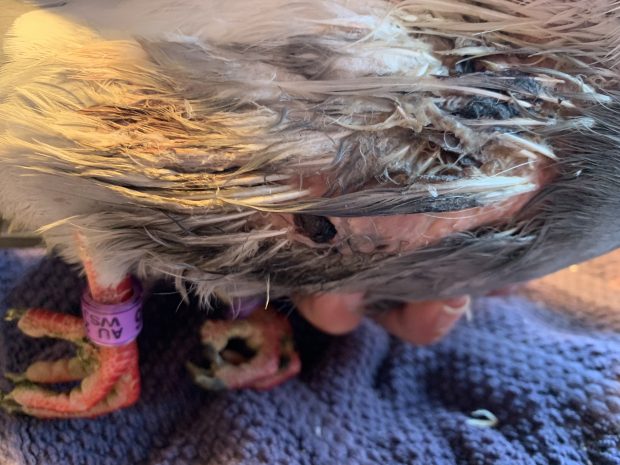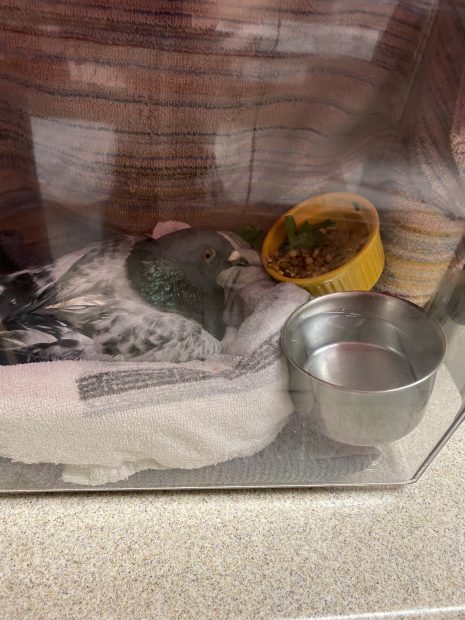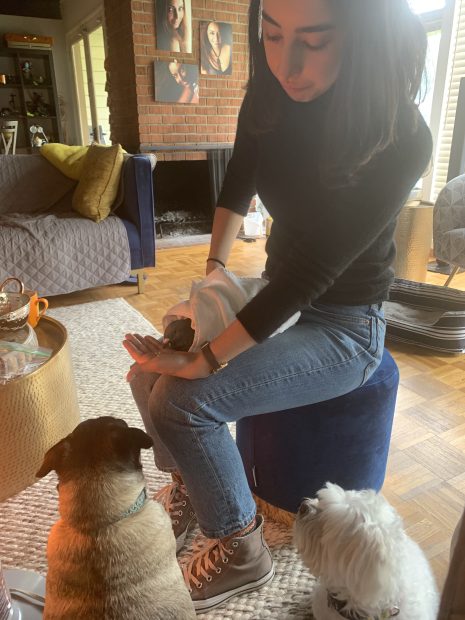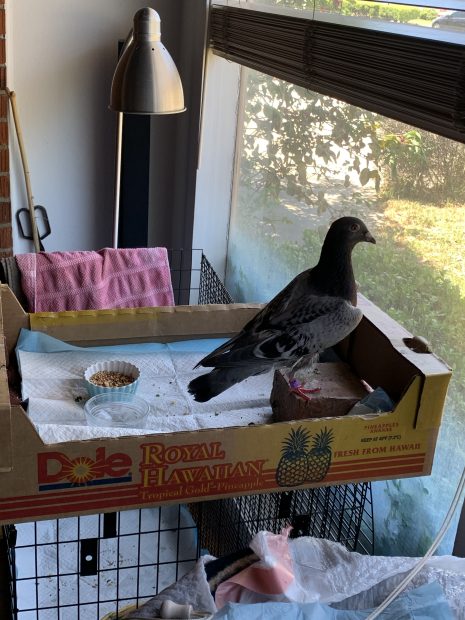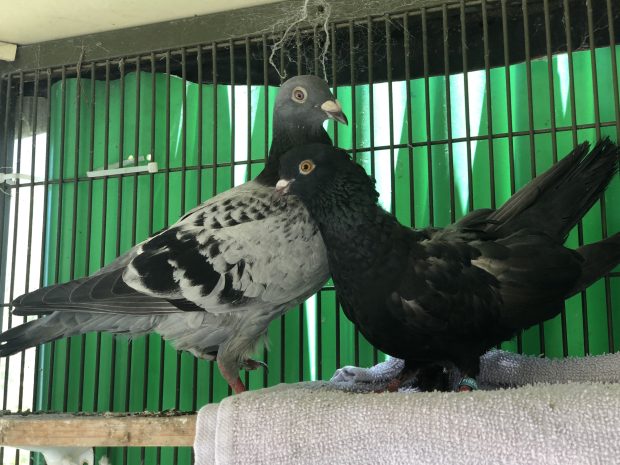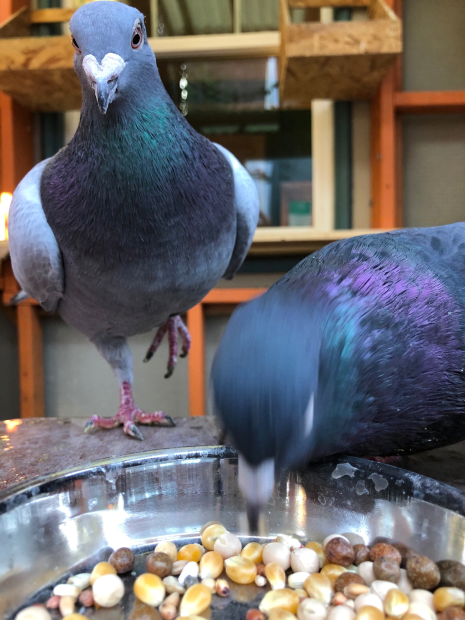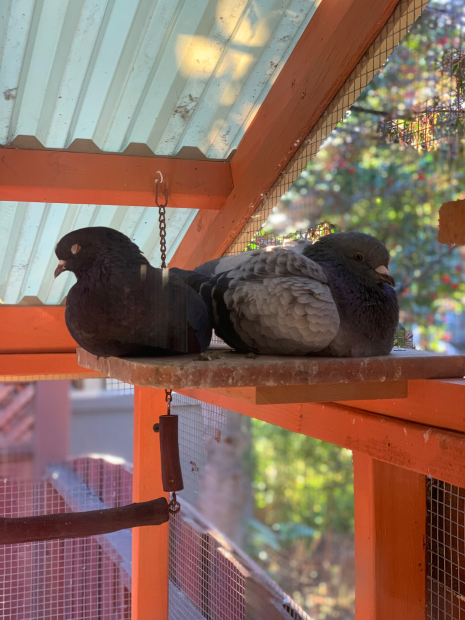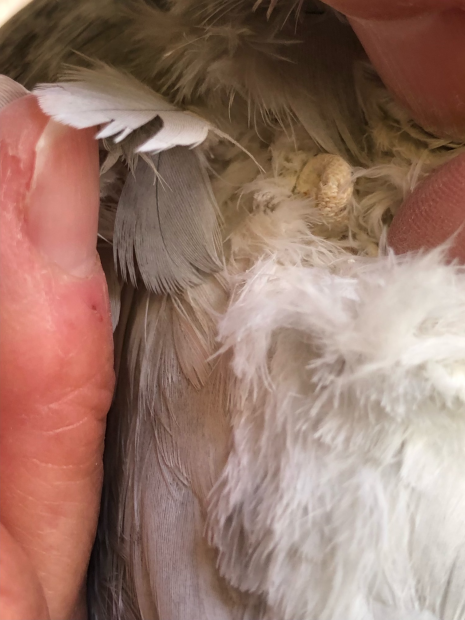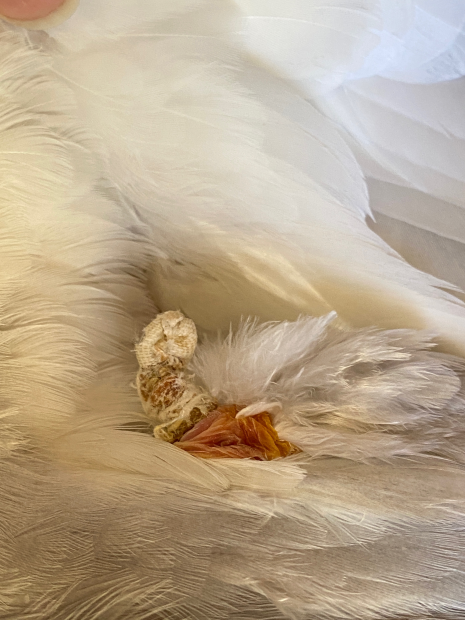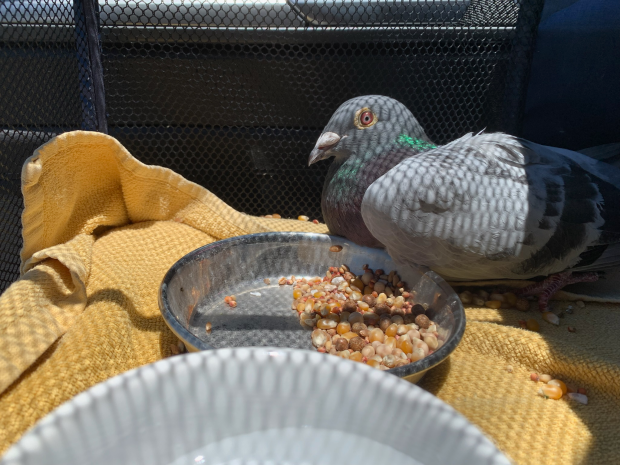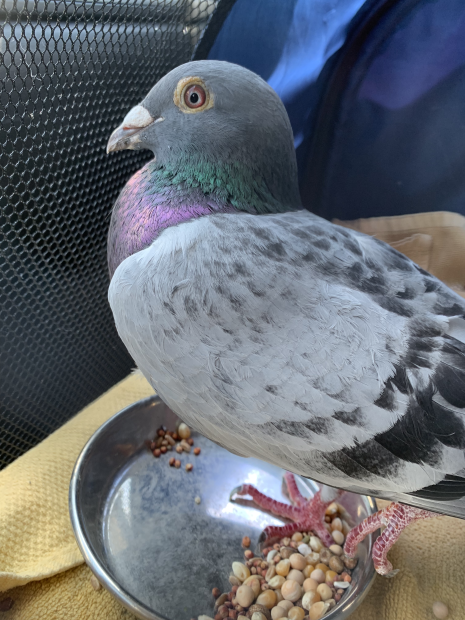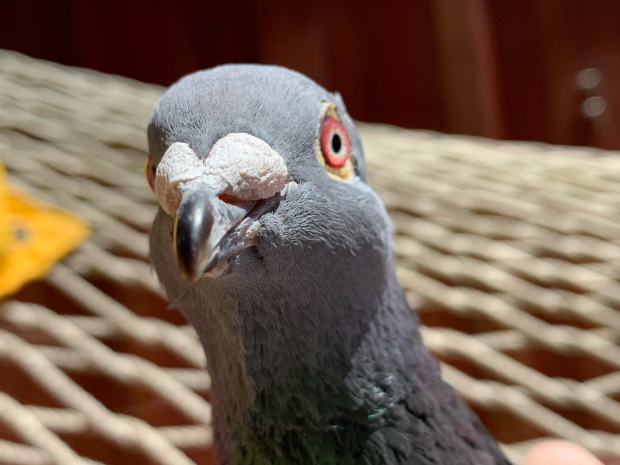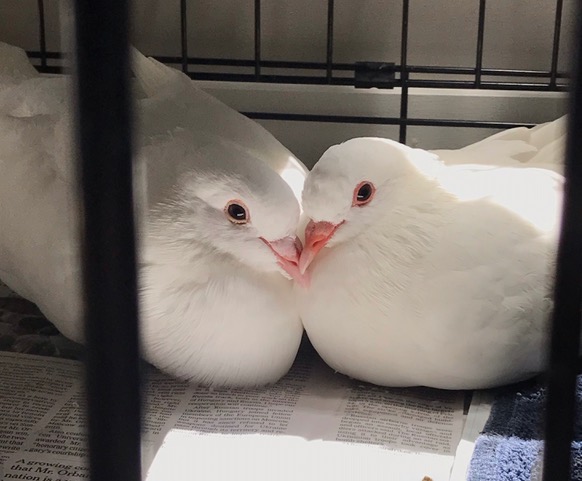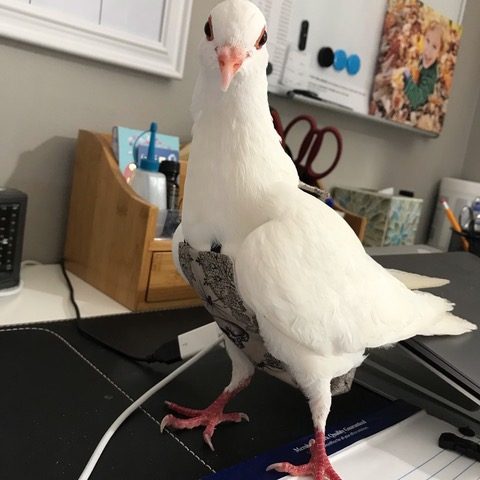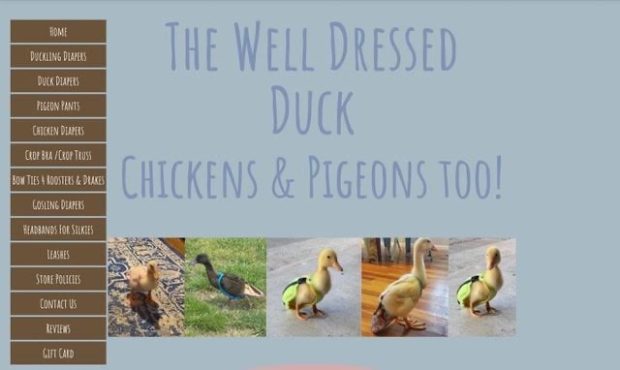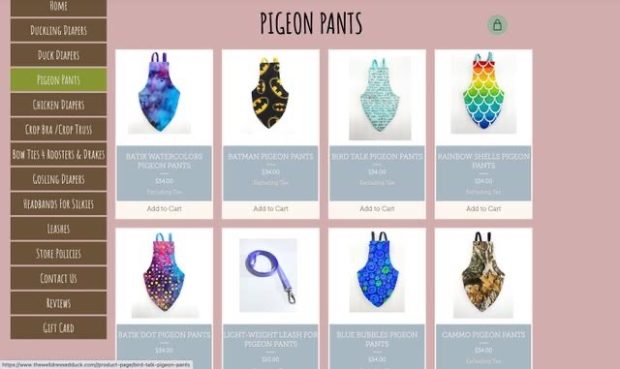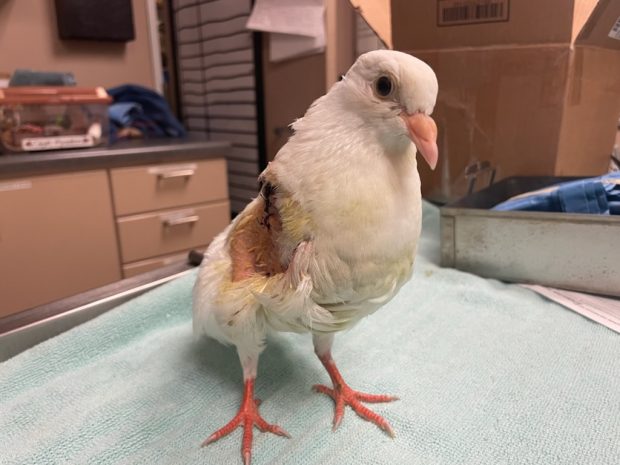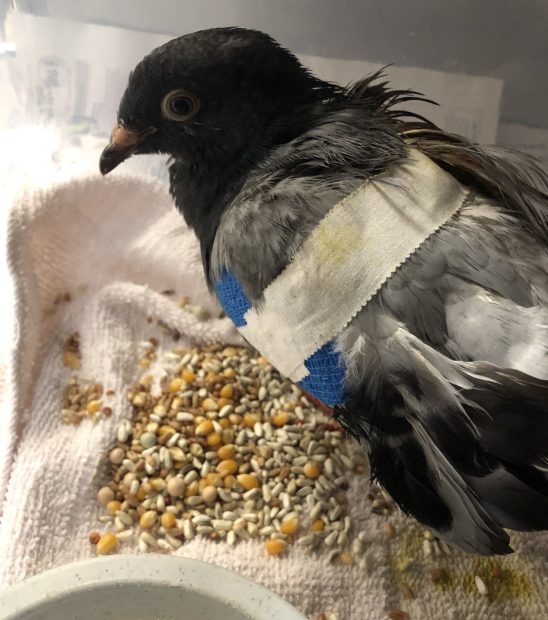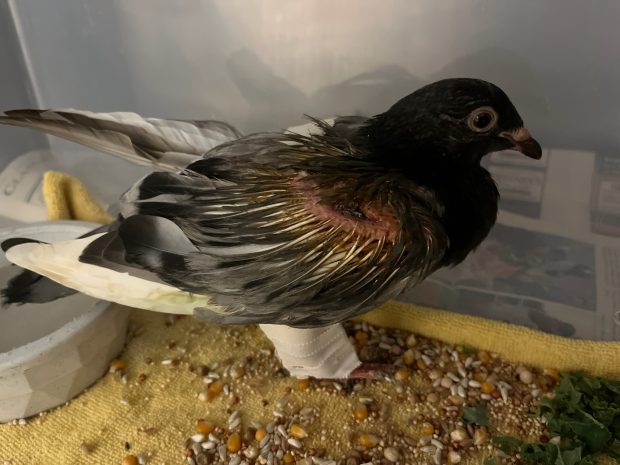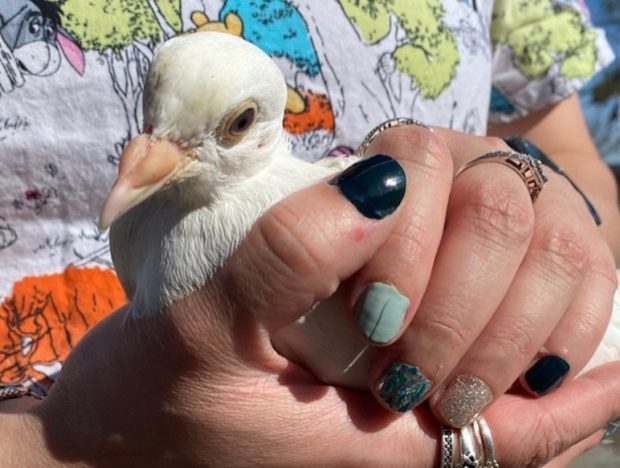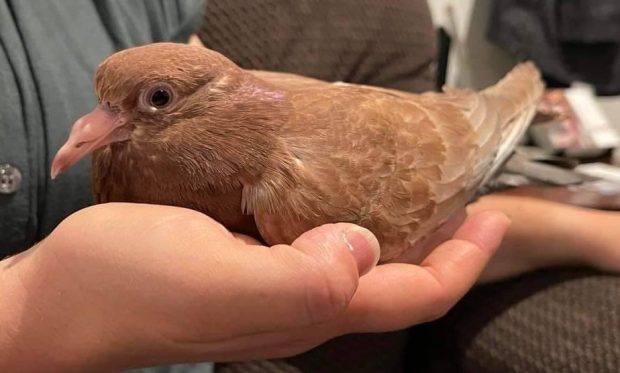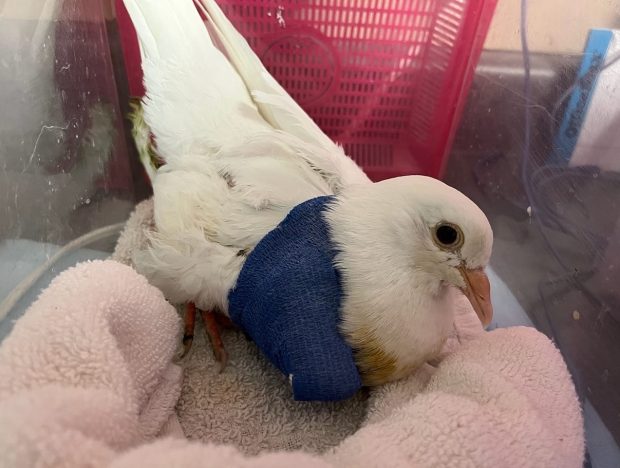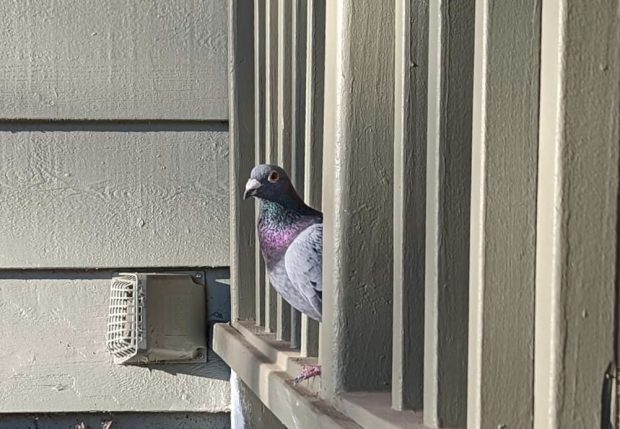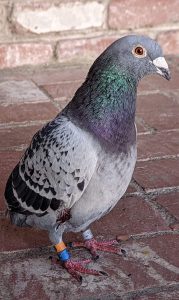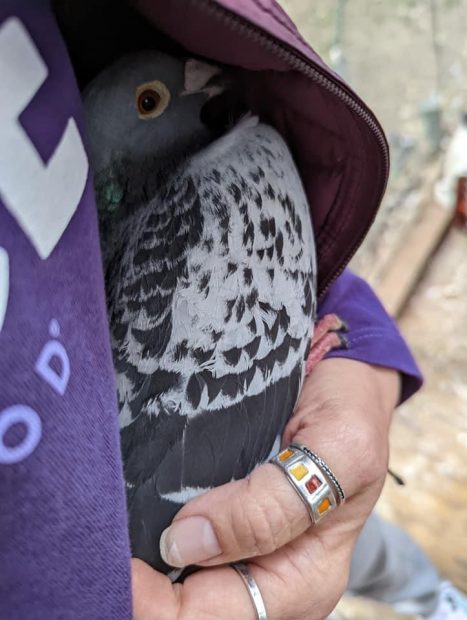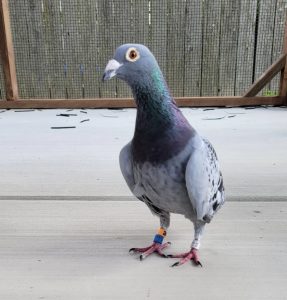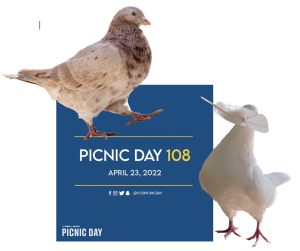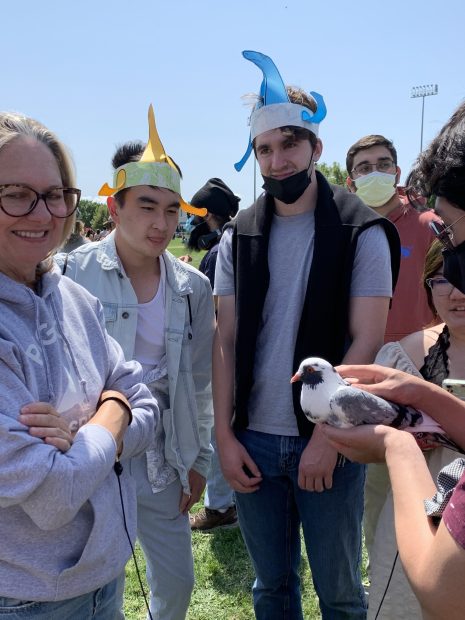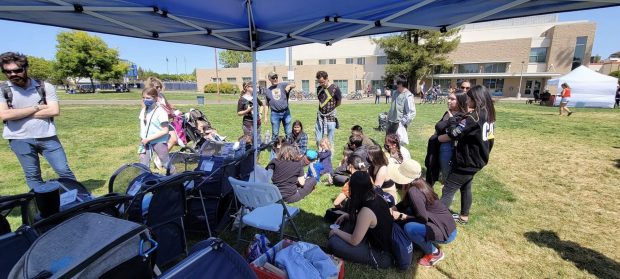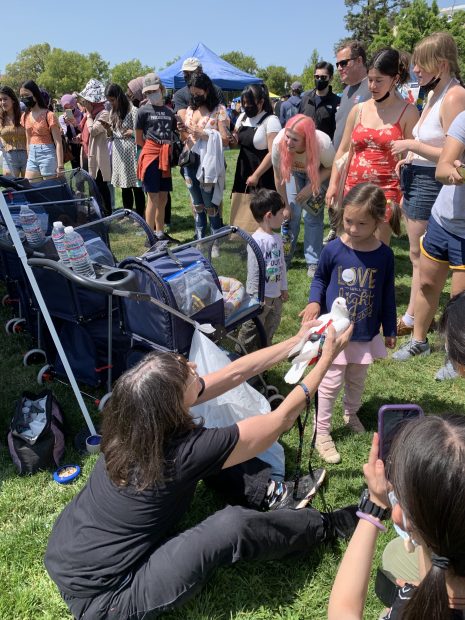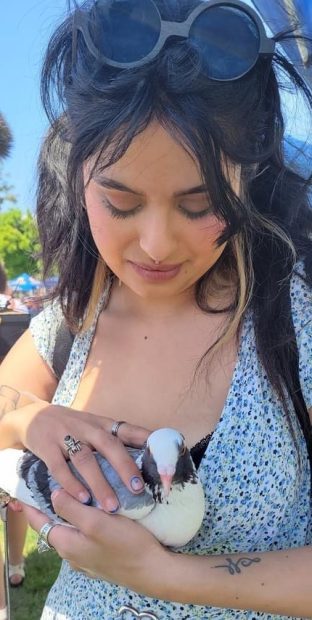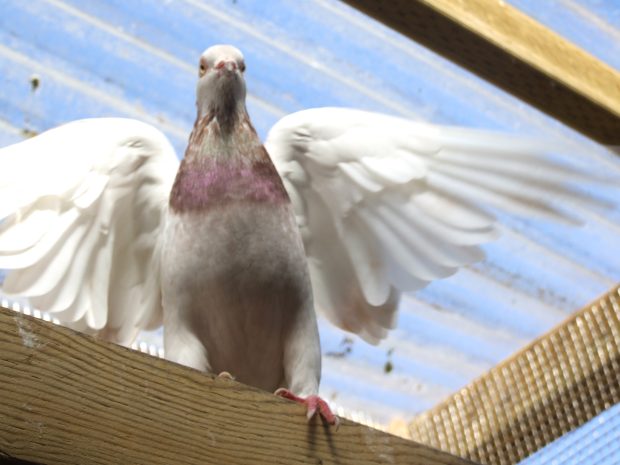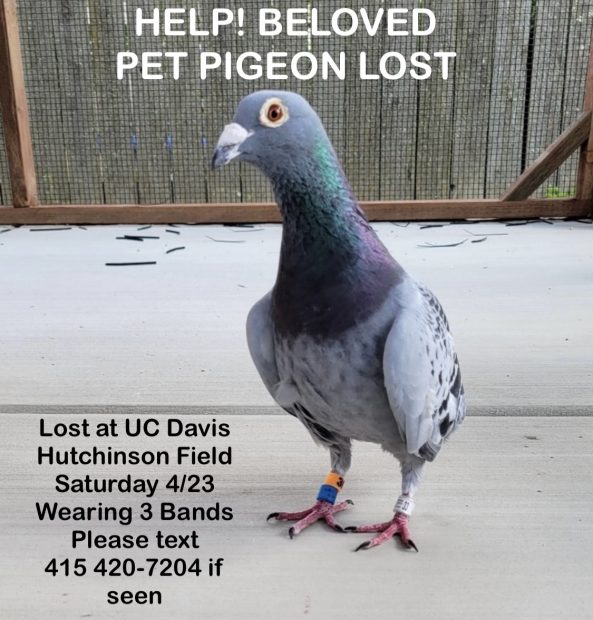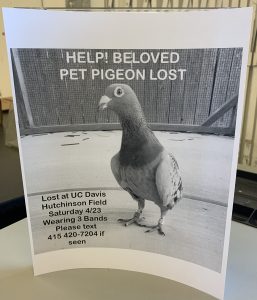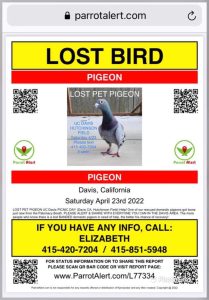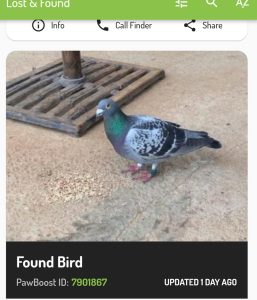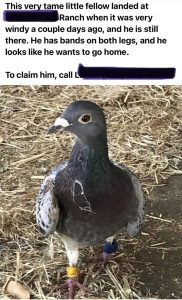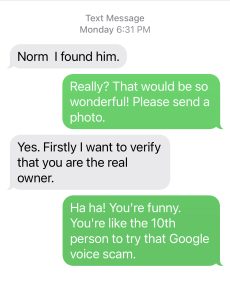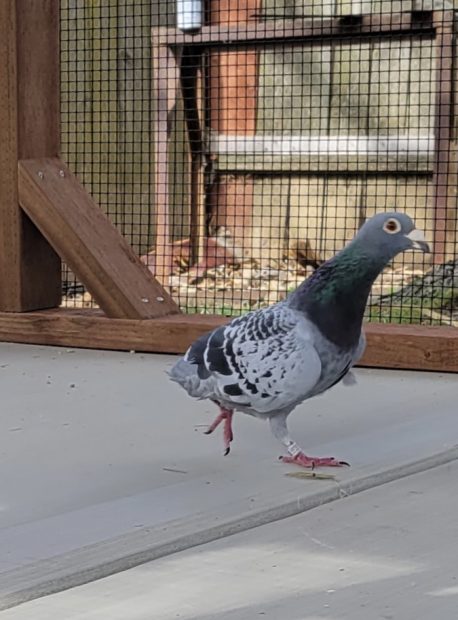Guest Post by Sandy Briggs
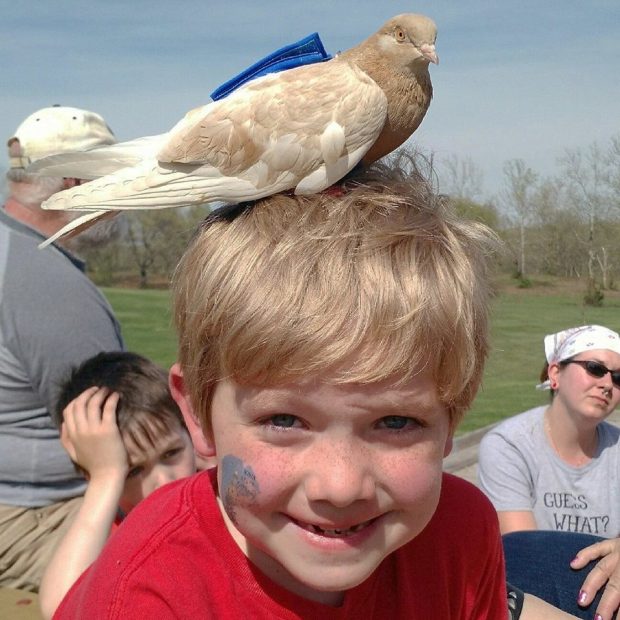
Paz on the head of one of my son’s friends. Thank goodness for flight suits!
The notion of such a thing as a Therapy Pigeon is difficult to explain to someone who doesn’t know pigeons but it’s obvious to those of us who know them.
Ozzie is my second pigeon. My first was Paz. My friend rescued Paz from a park in late October, here in Des Moines, Iowa. It was getting cold outside. He was let loose to die from the cold, or starvation, or a predator because his wing feathers had been clipped. My friend was able to scoop him up and take him home without difficulty. She had chickens so had some supplies to care for the pigeon while she tried to find the owner. Her detective work led to a dead end. She didn’t want to keep the pigeon and so with some husband finagling on my part, I kept the pigeon. My sons and I fell in love with this bird instantly. (Editor’s Note: Domestic pigeons are bred and used as if disposable but, when lost, they can’t survive on their own and need to be rescued and given a home. See What Is Palomacy?)
Once I had a pigeon and my first pet bird, I researched how to care for him, what to feed him and the size of cage etc. I was fascinated by all the pigeon facts. I of course found Palomacy as a resource and was able to find valuable info and an understanding pigeon community. The other item I ran across was flight suits. THAT was a game changer. I felt my family could now enjoy taking him out in a flight suit and leash. Anywhere that a dog was welcome in public, we should be able to take him too.
I would pick up my sons from elementary school and bring Paz with me on nice days. The kids all couldn’t wait to pet him. And for Paz’s part, he LOVED it! The more attention and petting he got the more he purred. Each kid wanted to hold him. It always took a long time to pick my son up when I had Paz! I don’t know if it’s true for all pigeons, but both I have had, don’t mind laying across my hands on their back. Paz let kids hold him like that, or he would stand on their heads. All the while, my son was telling them about Paz and pigeon facts we’d learned. Paz was a complete joy.
Then after two years of thinking Paz was a guy, SHE started laying eggs! Or at least tried to. She layed them but the shells were soft. The eggs always collapsed. I gave her extra calcium, I took her to an avian vet, who prescribed some medicine. But she never did lay eggs with hard shells. We had her for about three years when she passed away.
There was no doubt my sons and I wanted another pigeon. We had all the equipment now. We looked at animal rescue places for random pigeons. I went to the Iowa State Fair and got the contact for a breeder. I kept looking online for local pigeons to rescue.
Then one day my family and I were at church. I was in a play and we were all eating cookies and chatting. Then a lady serving punch looked at a window and said, isn’t that funny? The bird is right there and isn’t leaving. I looked toward the window and there was already a crowd of children pointing and looking at this bird perched on the outside pane. The bird had been there for 10 minutes. That was VERY weird. What bird does that? If he lost his footing, he flapped a bit but came right back to the window, in fact, closer down to where we were, instead of at the top of the window. I saw he had a band on his leg and headed straight for the door. My oldest son was right behind me. We went outside, the bird went from the window to the top of an air conditioning unit. My son, Robert, had been expert at catching Paz from the top of our refrigerator. He caught this one too. He seemed smaller than Paz. No injuries, no wounds, but definitely lost.
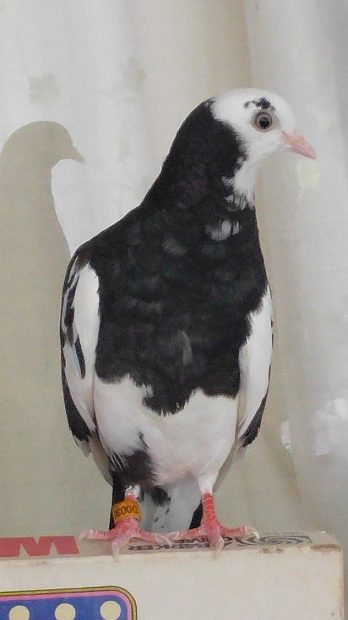
Ozzie the day we brought her home, doing her Penguin impression.
Of course I tried to find the previous owner for a few weeks, but I knew I wouldn’t. This one was mine. The only issue he had were feather mites. Other than that, the vet gave him a clean bill of health. We took care of the mites without problems. It was September, this little bird had no idea what he was in for, but neither did I!
We already had flight suits from Paz. My sons wanted the pigeon to be a male, and the striking black and white colorations helped him look sort of like a penguin. Now named Ozwald, after Batman’s nemesis Ozwald Cobblepot, aka the penguin, we were ready to roll. I was happy to see that the name Oz was actually gender neutral. It’s Hebrew for Strength or Courage. The following February, Oz started laying eggs so good thing for gender neutral names!
We enjoyed her at home, and took her to a pet blessing at church. The kids there all were so excited to see her again. And Ozzie was fine with it all, just as Paz had been. So I figured, that’s how pigeons are.
The following Spring, I was at an event for my local animal shelter, the Iowa Animal Rescue League (ARL). They had the usual dogs walking around collecting money from people in saddlebags but this time, there was also a DUCK!!! A DUCK on a leash!!! I made a bee line for the lady who was in charge of having these animals collecting money. I learned that each of them were therapy pets. In my mind I vowed, that if they had a therapy duck, there could be such a thing as a therapy PIGEON! Maybe I’m a bit competitive. (Just a little.) Anyway, at that moment, I was both inspired by this unusual therapy pet, and excited that Ozzie might be able to join in too.
I learned that there were classes and a certification process that all the therapy animals went through with the ARL. The criteria were created by the staff at the ARL. There are amazing people who’ve worked with all sorts of animals for years, even before starting work at the ARL. These are people very committed to the wellbeing of animals of all types.
They created criteria on how to be an effective therapy pet team. The criteria is different depending on what type of animal the pet is. While mostly the therapy pets are dogs, there are a few therapy cats, therapy bunnies, and at the time, Webster the therapy duck. In the classes, Ozzie and I learned how to handle crowds, emergencies, little kids, and how to be a team at the places we went. The final test was that Ozzie needed to be evaluated by a panel of people who wanted to see what she would do in different circumstances. It was ok if she flinched or tried to get away from loud noises, weird smells, excited strange hands, but they wanted to see how quickly she would recover from it. Would she actually be nice to strangers?
Let me tell you, the panel of people were all selected because they had experience with pet birds, mostly parrots, of various types. They had never met a pigeon before! We met in a conference room. Ozzie confidently walked across the table and stood on their hands and equipment. It didn’t matter what noise, hands, equipment, was thrown at her, she was aware of it, but didn’t flinch. They couldn’t believe how calm she was! Her talons didn’t hurt when she walked up their arms. They couldn’t fathom wrestling their parrots into a flight suit. She actually kissed one of the panelists on the hand. The panelist was laughing because it tickled. They took photos of her, they hadn’t thought she could be this way! When I laid her on her back in my hands, they were in total disbelief. “NO WAY!” was the phrase of the day. They all took photos and called other workers in from the hallway to see the pigeon spectacle. She had passed the panel with more than flying colors.
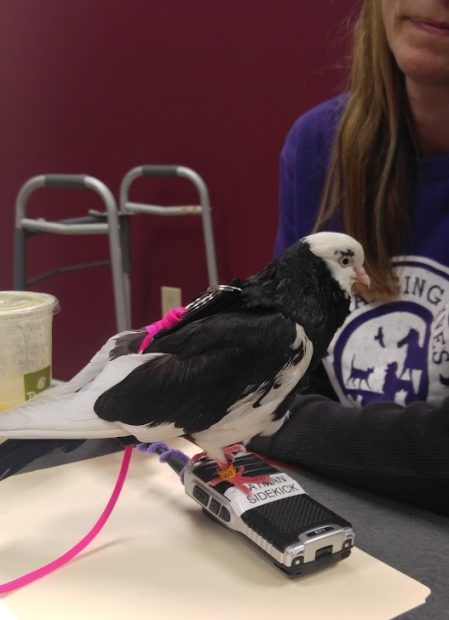
Ozzie at her panel review, securing a walkie-talkie from a worker.
Next, I went with the coordinator of the therapy pet program on a therapy pet session. She had her two African Grey parrots. They knew some words and one could imitate other animal sounds. It was fun to see them and to hear them. Then she talked about them. And the people asked questions or told stories of parrots they knew. It was really fun to be around the birds and cheer them on.
Now the adventure really started. The first few places we went, the coordinator went with us to see how we interacted with people and to see how people interacted with Ozzie. The first session was at a nursing home. We were in a lobby area. It couldn’t have gone better. Residents and their visiting families came over to us and wanted to pet her or hold her. I explained all about pigeons and some people reminisced about having farms with pigeons in the barn. Or they knew someone who kept pigeons.
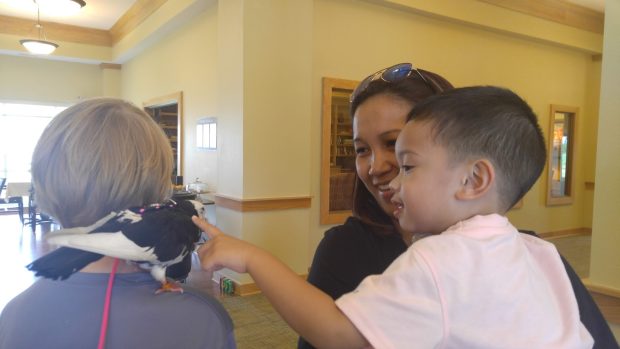
Ozzie’s first therapy pet session. On the shoulder of a new friend, while a mother holds her son to pet her wing. People often want to pet her so much, they don’t wait to have their own turn, as you can see.
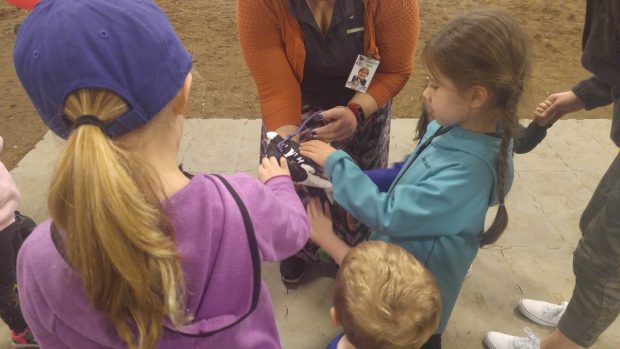
At another session, this is an event for kids to get close to animals.
Another event was outside and we were there with a therapy dog. We were there to explain therapy pets. People came by and petted them and took pictures. We found a way to pose the dog and people so that Ozzie could be in the photo with the dog. Ozzie and I were learning each session. After the event was over, we made our way back to my car and it took me 30 minutes to get there because people kept stopping us. Everyone wanted to hold her and take selfies with her. One snarly person asked, “What’s with the bird?” I explained, “She is a therapy pigeon.” He looked unconvinced. “What does a therapy pigeon do?” I said, “Hold out your hands.” He did. He gently held her. His face softened. He petted her, and the dawn of understanding came over him, “Oooooohhhh…” It was just that fast to teach people how gentle and comforting pigeons are.
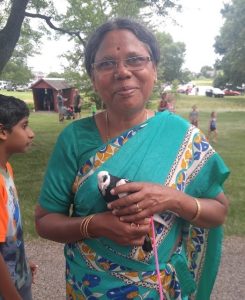
An appreciative admirer at an outdoor event.
She and I have been to nursing homes, schools, libraries and events were we represented therapy pets for the ARL. We visited students at schools for kids that need psychological counseling, before finals, as part of Health classes, etc. We’ve visited the teachers, who needed a therapy pet boost too. We went to an animal showcase event for kids to interact with different farm animals and our therapy pets. We were there with therapy dogs as usual. Between a pigeon or a dog, they wanted to meet a pigeon. That day, I had the privilege of introducing Ozzie to a couple of different small children. One was about three years old, the other maybe two. Their parents were excited for them to meet and touch Ozzie but the kids didn’t seem to understand what the big deal was. So I held Ozzie and gently caressed their cheek with her wing. I could see a huge light of pleasure explode in their little eyes. It was so fulfilling to teach these kids and their parents that pigeons are not dirty, they are gentle and loving. They make wonderful pets and are easy as pets in general. EVERYONE POOS. There are over 300 domestic breeds of pigeons. They mate for life. BOTH parents raise their babies equally. So don’t catch a wild pigeon as a pet, adopt one that needs a home. I go on and on. Our mission is to dispel the falsehoods people have heard and show and explain how awesome they are and have been throughout our mutual history.
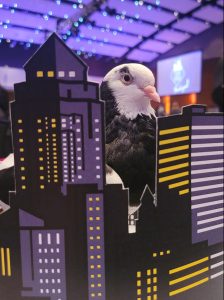
Ozzie worked at the animal rescue fundraising gala.
When Ozzie and I go to story times at libraries or are asked to talk about pigeons to kids, I relate how pigeons are like people. They come in lots of different shapes, sizes, and colors. I show them pigeon photos I’ve collected from pigeon calendars. I tell them, they have families, they live in groups like people do, and they have special skills and talents. Some fly fast. Some fly far. Some help the military, and science. Some are models because they’re so pretty. We talk about how pigeons show us they are happy and so on. I have the kids stand up and show me how they look when they are happy, and imitate a happy pigeon by standing on one leg. I have them clap their hands in front and behind them if they can, because that’s what happens when pigeons fly. Each session always ends with everyone petting, holding and taking selfies with Ozzie on their shoulder or head. And then asking if they can do it again. And again.
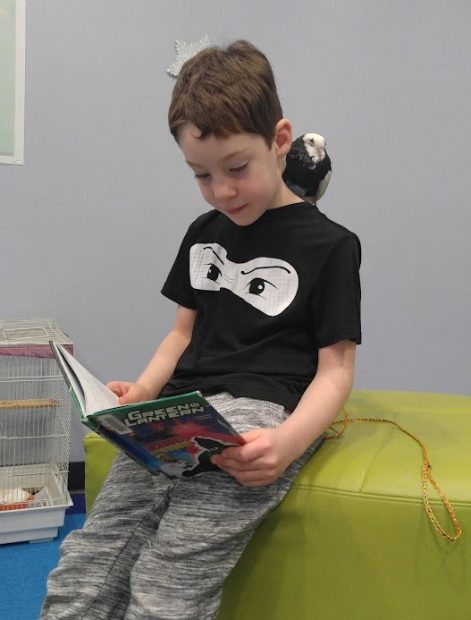
At a library session a little boy reads to Ozzie as Ozzie takes a snooze.
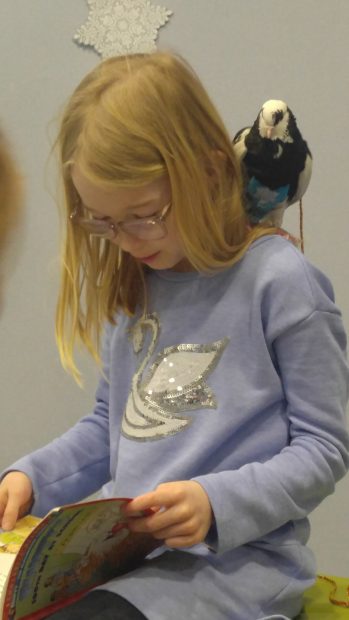
Here a little girl reads out loud to Ozzie while Ozzie looks at the illustrations.
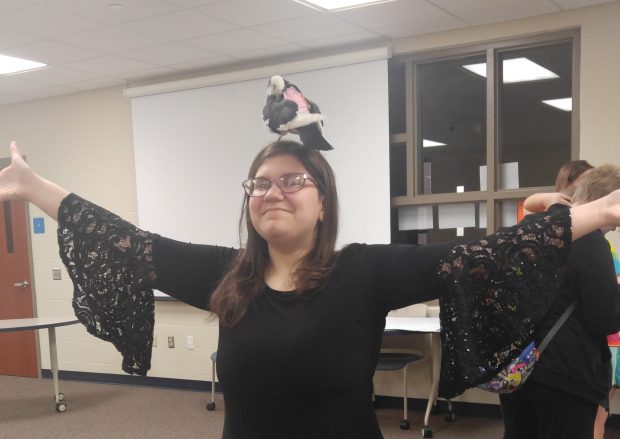
Ozzie goes to High Schools & Middle Schools to help stressed students though their finals.
Of course, not everyone in the world sees a bird, even a calm one in my hands, and is excited about it. I am surprised by the number of people who are afraid of birds. So that also became part of our mission. I show how she is wearing “Pigeon Pants” so she won’t poo on anything. Usually that makes them laugh and eliminates at least half of what concerns them with birds. Then I hold Ozzie so she is in my hand but doesn’t flap her wings. I ask them just to touch her wing. They are reluctant, but I keep telling them, she won’t flap, she won’t fly at them. I’m holding her. Just touch her. I understand they have their fear. Who knows why, but I want them to know that at least THIS bird won’t hurt them in any way. If they just stroke her wing, it’s a win over their fear. So many times, they pet her. They like it, then eventually, they wouldn’t mind holding her. In some cases, it’s hard to get her BACK!
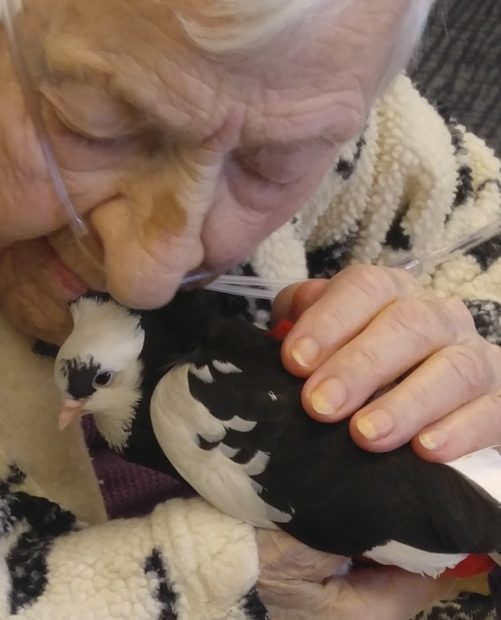
This is my favorite therapy session photo. Ozzie with a 99 year-old nursing home resident. She REALLY loved on Ozzie.
She and I went to the Veterans’ Hospital. There was a resident there, Bailey, who swore that Ozzie liked her best and almost wouldn’t let anyone else touch her. Bailey summed up her experience this way. “Dogs are great. I’ve had dogs, everyone loves a dog. But there’s something about touching the untouchable. That’s what’s going on with Ozzie.”
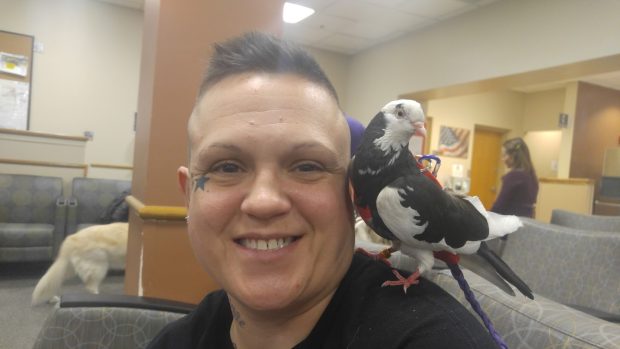
Ozzie & Bailey at the Veteran’s Hospital.
My personal belief is that all pigeons are Therapy Pigeons. That doesn’t mean everyone needs to go through a certification process and take their pigeon out to schools and libraries. As a team, we need to be aware of our own bird’s personality, likes and dislikes. I’ve only had my two, and they both love the crowds, but it might not be for all pigeons. Maybe your pigeon is for your own therapy. If you do think you’d like to volunteer, look into your local animal shelters who have animal therapy programs. Maybe they have a certification process to become a therapy team. If not, try PetPartners.com. They do accept therapy birds and have training courses. Some places accept pigeon therapy pets via Zoom or as a recorded video session.
No matter how you do it, it’s up to us to share the pigeon love.
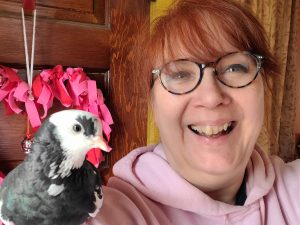
Sandy Briggs I’m a life -long Iowan, but I’m not from a farm. I’ve worked for Iowa State Government for 28 years, competed college here, married, and my husband and I are almost done raising two boys (if there’s such a thing as being done raising kids). Anyway, the whole sha-bang in Iowa, which of course means I like to travel to anywhere I can get to.
I’ve loved animals and had various pets my whole life. In 2014, my first pigeon came into my life, and things have never been the same. I KNOW you know what I mean.
I don’t know any other therapy pigeon teams. If you’re out there, I’d like to know you!
If you would like to volunteer and become a therapy pigeon team, check with your local animal therapy organizations to see if they’ll let you certify. (Check out www.PetPartners.org)
Other than that, wave next time you fly over Iowa!
